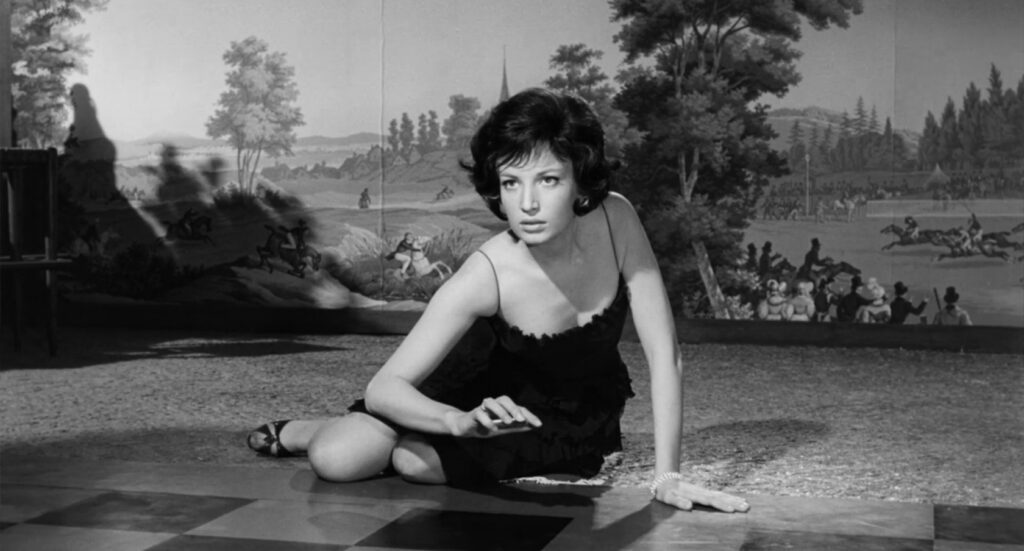
La notte
1961, directed by Michelangelo Antonioni
In order to appreciate what makes La notte extraordinary, let us do a brief archaeology of five films that represent a somewhat universal rule of cinema. Sunrise (1927) begins with a train leaving a station and ends with the sun rising. Modern Times (1936) features a clock in the opening titles and ends with the Tramp and the Girl walking up a highway toward the mountains, their backs to the camera. Casablanca (1942) begins with a globe spinning and ends like Modern Times with two characters walking into the distance, although more importantly the last scene includes the famous line “We’ll always have Paris.” Ugetsu monogatari (1953) begins with a horizontal pan over a rural landscape and ends with a rising crane shot of the same landscape. Lastly, after a brief prelude Wild Strawberries (1957) begins with Professor Borg’s nightmare of time running out, and it ends with the old professor facing his young parents as if crossing a gulf of time.
Each of the dominant opening images – a train, a clock, a globe, a pan, signs of approaching death – expresses forward motion, either in space or time. Each film ends with vertical motion or some more direct expression of eternity – time at a standstill, or life transcending time. These examples are not at all unique, and although not all movies fit the pattern, there’s still something natural and almost universal about beginning a movie with a feeling of progress and ending it with a sense of resolution.
La notte reverses this formula. An opening shot juxtaposes the Pirelli Building, a symbol of modern Milan, against an aged and ornate neo-Renaissance building. Like the end of Wild Strawberries, past and future co-exist. A truck and a bus pass in opposite directions, the camera tilts up, and we’re taken to the top of the Pirelli where the signature shots of the opening titles descend along the skyscraper’s reflective facade. The film ends horizontally with a tracking shot reversing Lidia’s and Giovanni’s path through the golf course.
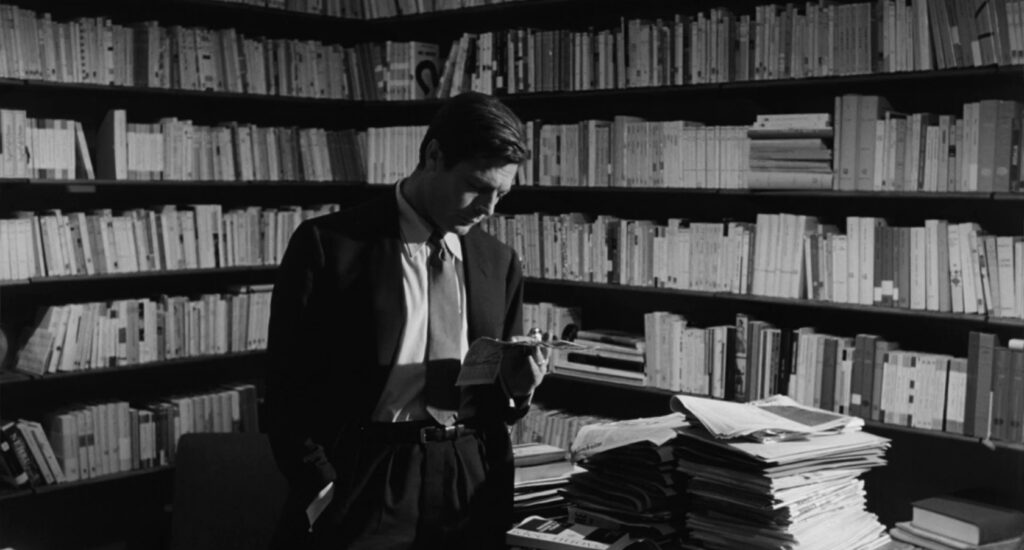
There are doubtless many other films that begin with vertical motion and end with progressive motion, but La notte shows every sign of doing this purposefully, because the movie is exactly what we should expect when a film consciously flips the narrative force of its beginning and ending. Almost every movie uses its opening, in one way or another, to draw the audience in, and its ending to close the story. La notte, on the other hand, does absolutely nothing to draw the viewer into any story. Why should anyone care what the Pontanos are going to do next, where Lidia will walk as she crosses Milan, whether they go to the nightclub or to the Gherardinis’ party? The incidents are connected not by any narrative logic or dramatic necessity, but the way everyday incidents are connected in real life. The viewer must want to enter, and only then will the movie share its rewards.
By that last shot on the golf course, we can finally look back on the last few hours of the couple’s life with a sense that something like a story has unfolded. At last the movie makes a gesture to draw us in, yet the ending is as open as most films’ beginnings. La notte, in short, is like a movie in reverse, and it must have taken supreme confidence to make it that way.
Besides refusing to seduce the audience with any form of curiosity or suspense, La notte goes even further than L’avventura in suppressing the dramatic. While Tommaso lies suffering on his deathbed, the scene steers away from pain and pity. The encounter with the nymphomaniac fizzles quickly as the nurses come in and Giovanni leaves embarrassed. When Giovanni confesses the incident Lidia shrugs it off, when under almost any other director she would have freaked out. The book signing party feels more like a routine event for Giovanni than a moment of triumph. Lidia witnesses a street fight, but the violence rapidly turns to nothing. Valentina’s game on the checkered floor gets cut off twice, both her private game with Giovanni and their public contest, before turning dramatic. When Lidia spies her husband kissing Valentina, when Lidia goes off with Roberto, when Giovanni provokes Roberto, or when Lidia and Valentina meet, the situation always resolves without a climax.
Without any real plot or drama to guide the viewer through its two hours, La notte is not off-putting either. That too would be a form of seduction. Its incidents and events are normal enough. Watching the movie requires not so much patience as investment, and its central scene gives us a metaphor for the leap needed to view it properly. Right before the party Giovanni and Lidia go to a nightclub where a woman dances with a glass of wine on her forehead. At the end of her routine she stands upside-down, inverting herself as La notte itself is inverted, and in this position she finally drinks the wine she has been balancing. By the looks of it, however, it’s more like she pours herself into the glass, displacing the wine. If we watch the movie the same way, pouring ourselves into it, the experience will pay off at least as much as any film that bends to our wishes.
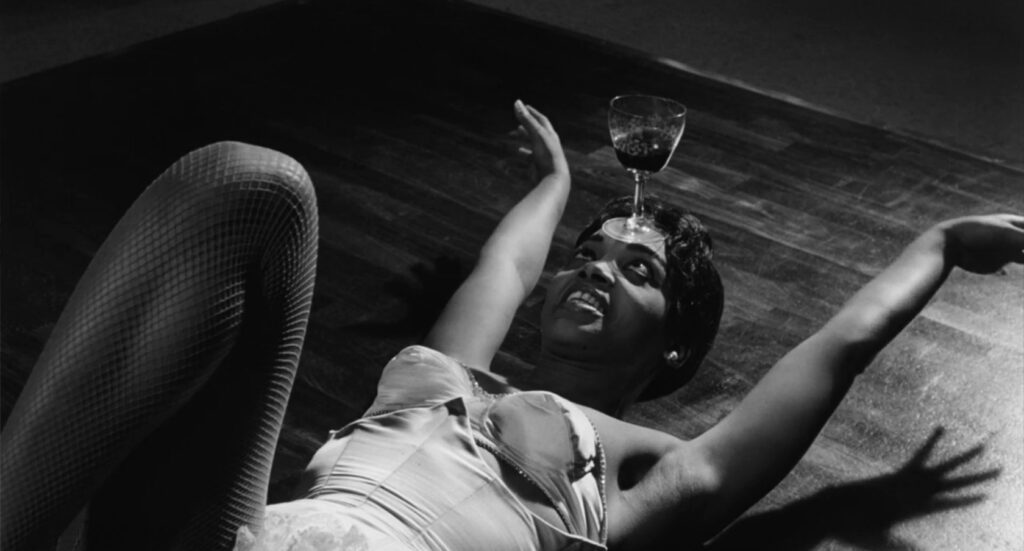
The glass of wine works as a metaphor, but it’s also paired with Lidia’s secret thought whose onset she traces with her finger until it comes to rest on her head. A single glance from Giovanni links this thought on top of Lidia’s head with the glass on top of the dancer’s head. The thought brackets the couple’s night out, as she reveals it at dawn on the golf course. Lidia wishes she were already old or dead so that her marriage to Giovanni would be played out, because she can no longer love him. However much we may understand her feelings toward Giovanni, her wish is a rejection of life. The movie does not pass judgment on her, nor does it make her a heroine who triumphantly finds enlightenment at the end. Instead La notte looks at life with an intensity that Lidia has lost, and it shows us the way out of her predicament.
Going back to the opening shot, the juxtaposition of the two buildings is not only a clue to La notte‘s narrative strategy, its inversion of beginning and ending; it also points to time itself, the past and the future, like the truck and bus passing in opposite directions. The long descent down the Pirelli shows the architecture of the future, but it also reflects the older city behind the camera or to the left side. Much like Casablanca, La notte is filled with allusions to time, including the title itself and Giovanni’s new book, The Season. Tommaso speaks of the past and the future, reminiscing on his friendships, predicting that hospitals will soon be like nightclubs (whereupon a nurse delivers champagne), and telling his mother to welcome his friends to her house “someday”. At Giovanni’s book release party a distinguished writer tells him he’s in the “anteroom to fame” adding that he’s been there before. On Lidia’s solo walk she stops in some war ruins (the past) and finds a little girl crying (the future generation). She watches men shooting rockets as a bystander talks about going to the moon. Giovanni picks her up, and they reminisce about a place they used to go when they were courting. At the party Berenice tells Lidia about the effect of the years on her face, and Lidia tells Valentina about the weight of her years. Giovanni flatters Gherardini, telling him the future belongs to industrialists; they have a brief discussion about “the future”, and Giovanni considers a job offer. Toward the end Lidia reflects on her past with Tommaso.
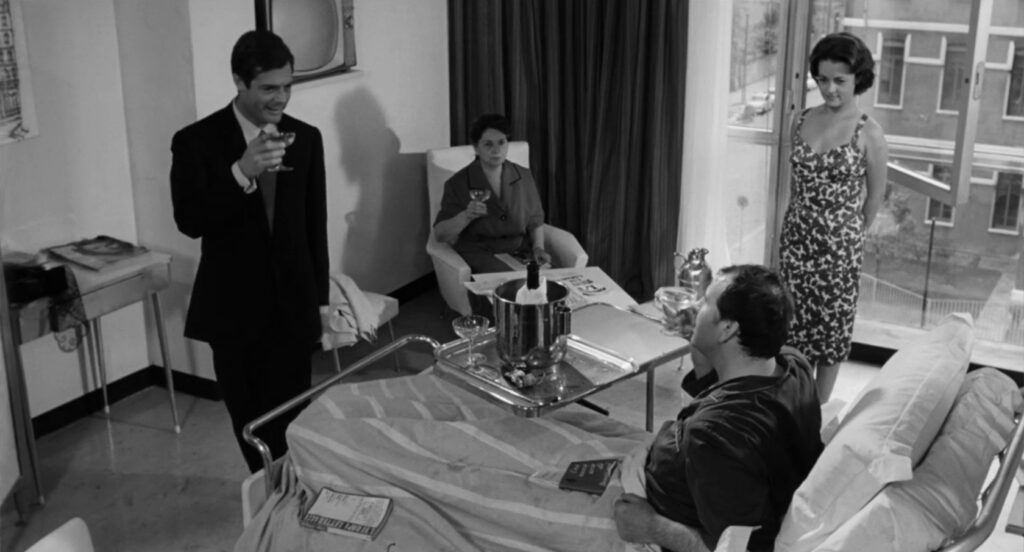
When Lidia reads Giovanni his love letter to her from years back, it speaks of seeing in one moment their whole lives together, past and future simultaneously: “I saw you in a dimension that encompassed all the times of my life, all the years to come, even the years past as I was preparing to meet you.” Now both of them have lost this vision of time, but the movie has given it to us. The movie spans about seventeen hours, from one in the afternoon until early the next morning, but this narrow slot of time is like a keyhole through which we can view lives and history extending in both directions. It’s not the first film to do this, but unlike Casablanca or Wild Strawberries for example, La notte achieves it without using flashbacks.
Given how thoroughly La notte plays with time, Valentina’s role begins to look like more than the obligatory “other woman”. We can also see her, if we choose, as an incarnation of Lidia at the age when she met her husband. When the two women first see each other there’s a jarring cut as if Lidia does a double take at the top of the stairway, signalling a kind of recognition. Both women come from wealthy families, both love to read books, and both presumably attract Giovanni at the same age. Viewing them as the same woman twenty years apart would explain the uncanny sympathy between them, why Lidia first points Giovanni to Valentina so flatteringly, why he’s attracted to Valentina, and furthermore it reconciles his claim that he still loves his wife at the end. Of course we can view Giovanni as a cad who professes his love for Lidia out of habit or insincerity; after all he’s fallen for two other women in one day and forgets his love letter. On the other hand, he voluntarily confesses his moment with the nymphomaniac, and he did write the love letter in the first place. His attraction to Valentina may simply reflect a wish to return to a past happiness with his wife, or it could be that he’s easily seduced because his wife no longer loves him – but most viewers will assume the reverse.
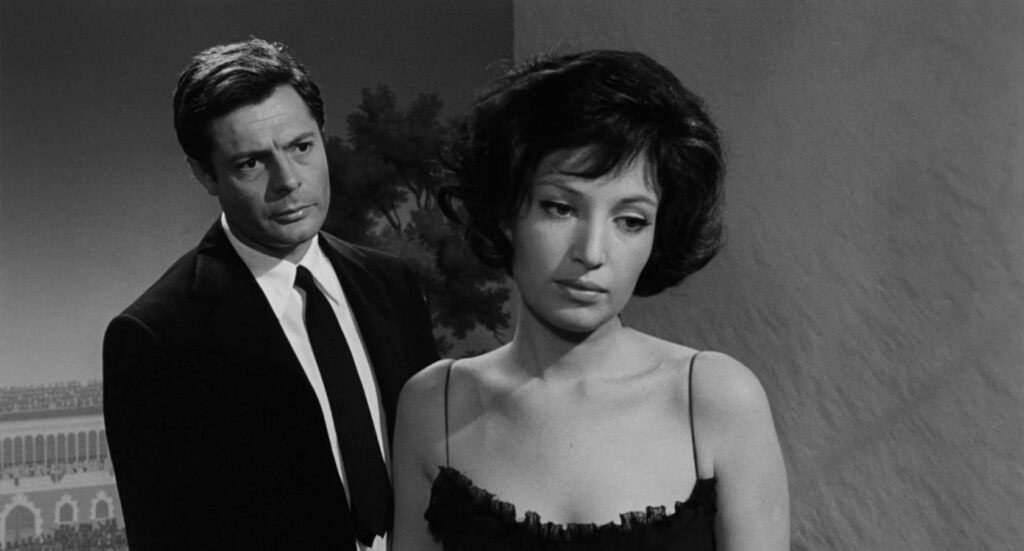
In keeping with this notion of Valentina as a phantom of Lidia’s past, she is so closely identified with the night that she’s almost synonymous with it, as if the title refers to her. She’s the central figure in the long party scene, which begins with a celebration of her racehorse, and when she disappears the night disappears too. The night is framed by two dances, one in the nightclub and then a highly choreographed farewell scene – set to offscreen music similar to the nightclub music – where the three protagonists approach each other, turn away, kiss, and separate in a graceful and intricate series of coordinated motions. When Valentina taps a hidden pedal near the curtain to turn off the light, extending her right leg and drawing it back with all the elegance of a dance step, precisely in time with the music, the room suddenly blackens, and her silhouette reveals the first light of morning behind her. It’s the last we see of her.
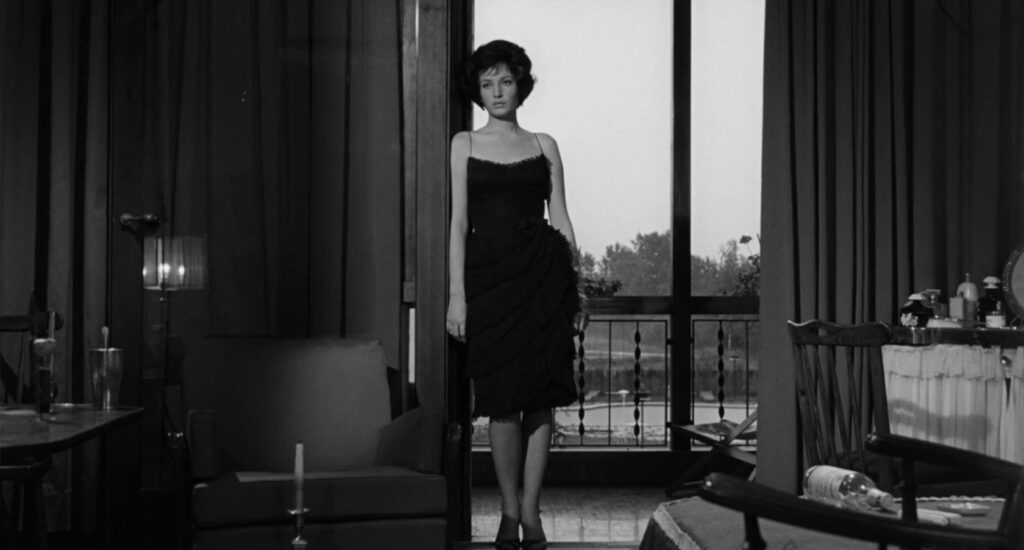
Insofar as Valentina represents Lidia’s past, she also reveals the way out of Lidia’s despair. Instead of rejecting life, Valentina claims to like “everything”. She plays a tape recording of her thoughts: “The park is full of silence made up of sounds. If you press your ear against a tree and listen, after a while you hear a sound. Perhaps it comes from within us, but I prefer to think it’s the tree.” Whatever else this means, it certainly shows a total embrace of the wonder of life, which is exactly what Lidia lacks right now. If Lidia was ever like Valentina, then she only has to open her memory to renew her freshness of vision.
If Valentina can find so much wonder in a tree, the movie gives us the same opportunity near the end when Giovanni and Lidia stand by a pair of trees that mirror their two figures – one straight, the other with a feminine curve. Like the palindromic echoes in L’avventura, La notte is filled with small coincidences, marvels of life, and visual wonders that sharpen the viewer’s attention and facilitate a deeper vision of the world. Entering Tommaso’s hospital, Lidia’s dress momentarily merges with the dress of another woman with a nearly identical floral pattern. After Lidia halts a fight with “Basta!” and the fighter calls her to wait, her cab driver says “basta” to a gas station attendant then asks Lidia if he should wait. Each half of the movie has bird cages, tape recordings, and a man startled out of sleep. Tommaso’s opening question, “What should I do?” is mirrored by Giovanni’s question near the end: “What can I say?” In each half Lidia retreats from a man interested in her, Tommaso and Roberto, and Giovanni gives in to temptation with the nymphomaniac and with Valentina. Lidia takes solo walks in each half, and in the middle nightclub scene she walks across the table with her fingers. A number of arresting painterly compositions add to the visual wonder, like the nymphomaniac framed against a stark white background, Lidia walking into a sliver of open space on the edge of a tiled facade, or the almost abstract shots of Lidia and Roberto through a rain-streaked car window.
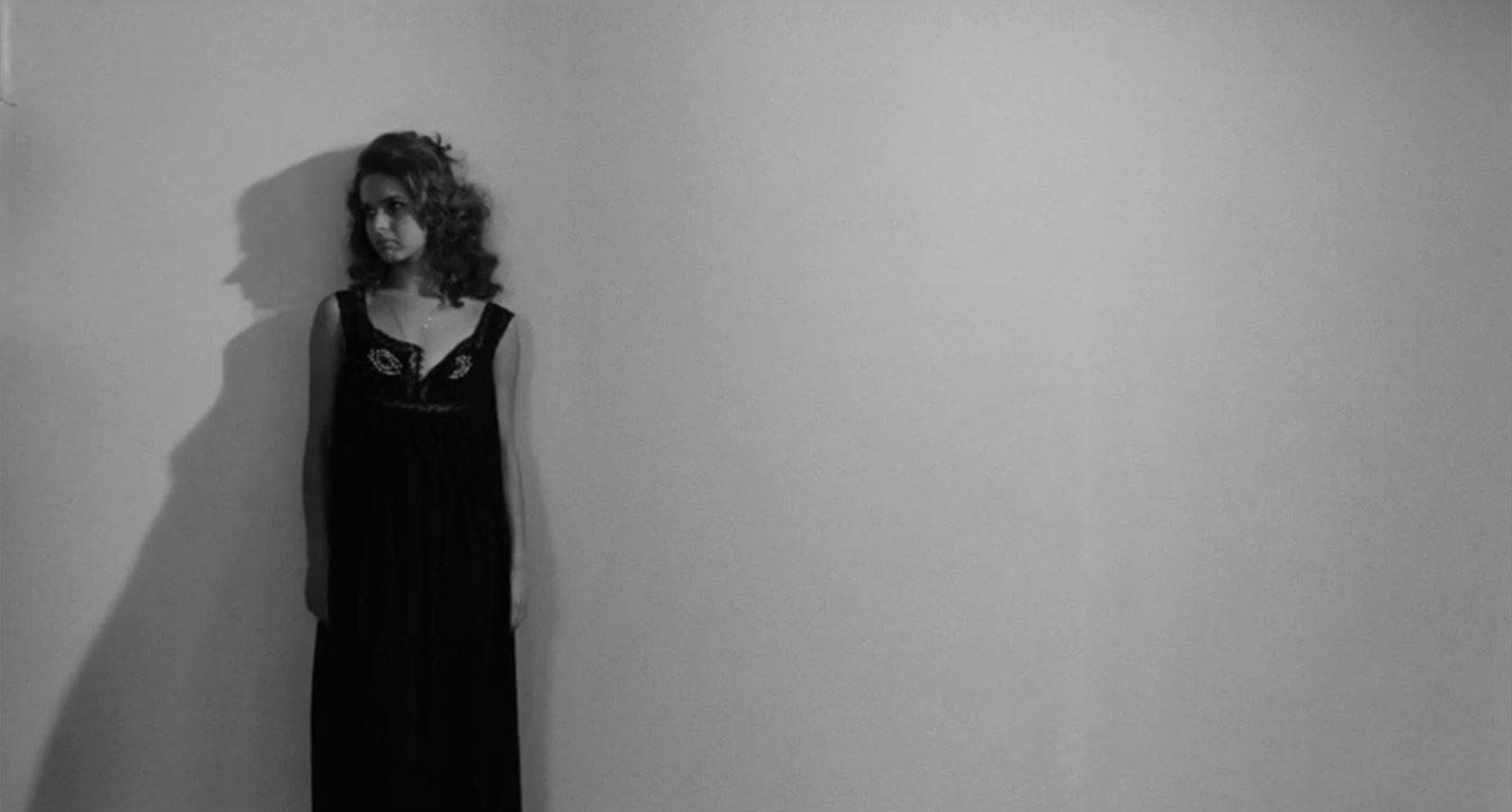
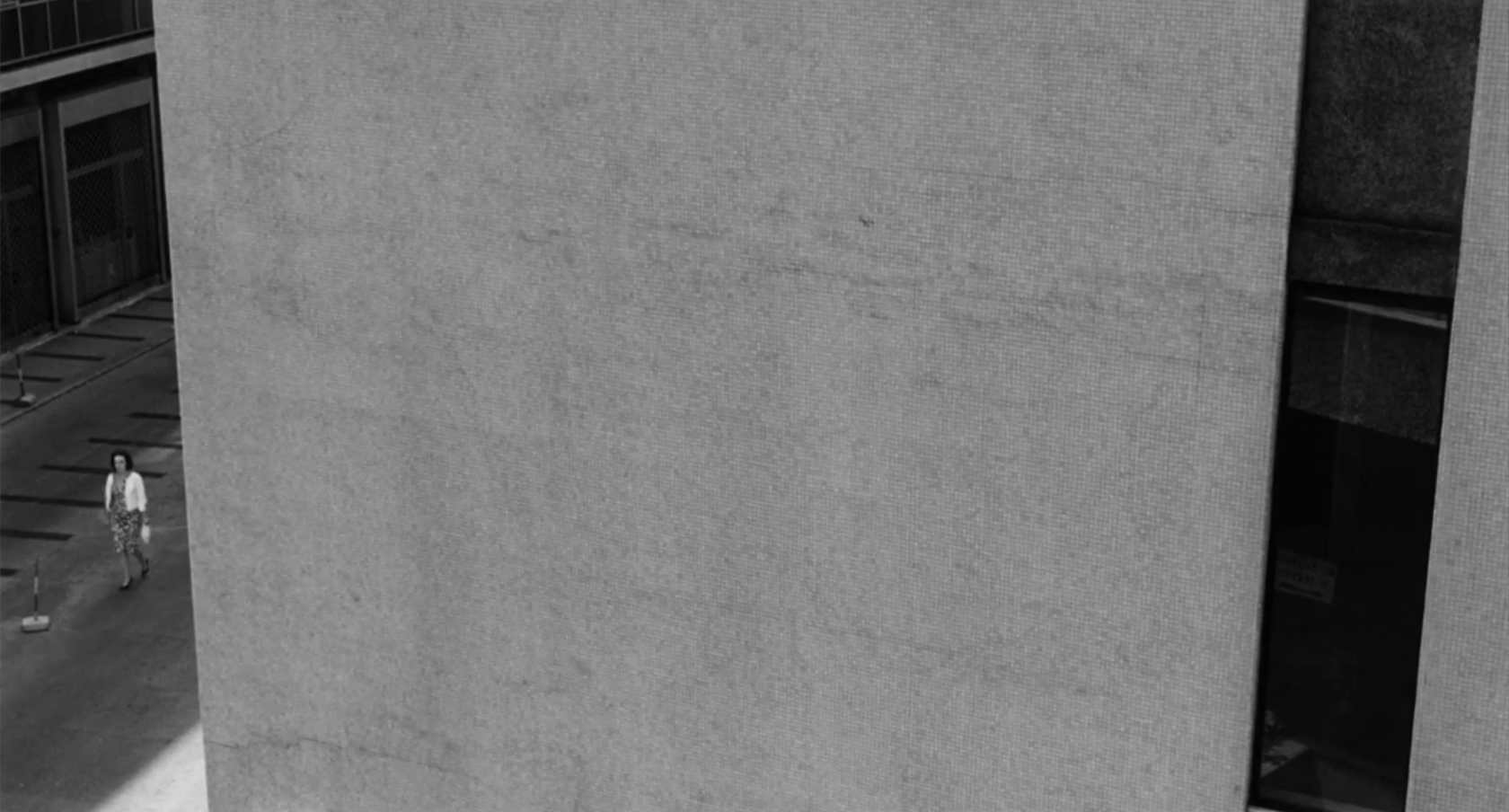
How one looks at these symmetries and visual marvels is up to the viewer. The two trees paired with Lidia and Giovanni are either commonplace or extraordinary, and in choosing which the viewer decides whether or not to enter the movie. At the nightclub Lidia chooses to reject her life, but the dancer pours herself into it.
La notte was shot in 1960, a momentous year for Italian cinema. Nearly ten years after the flowering of neorealism, two films at the Cannes Film Festival put the country’s cinema back in the world’s eye: Antonioni’s own L’avventura, which won a Jury Prize for “seeking to create a new language of cinema” and Federico Fellini’s La dolce vita, which won the Palme d’or and was a worldwide box office smash. La notte works as a corrective to both the literalism of neorealism and the over-the-top fantasies of Fellini, two poles that define so much of cinema, in Italy and elsewhere.
La notte‘s parallels to La dolce vita are too extensive to be accidental. Both star Marcello Mastroianni as a writer attending decadent house parties and witnessing the frivolous behavior of the upper class. Both feature a satyr, a black horse, a rainstorm, and a helicopter, but La notte strips everything of its sentimental, dramatic, or sensationalist flavor. Instead of a helicopter carrying a giant crucifix over sunbathing beauties on Rome’s rooftops, a random helicopter simply passes outside Tommaso’s hospital, barely dipping into view – yet its thunderous noise and graceful movement make it a more impressive object of wonder than Fellini’s helicopter, which by comparison is clamoring for attention. La dolce vita ends with great sentiment on a beach; La notte ends with serious reflection in a golf bunker. In place of La dolce vita‘s trademark scene of Anita Ekberg frolicking in the Trevi Fountain, the party guests in La notte leap into a swimming pool – but just as Lidia is about to jump in, Roberto takes her hand and says, “Don’t be foolish.” It’s hard not to infer a critique of Fellini in Roberto’s words. Antonioni knows he cannot force his audience to see life better by thrusting it in their faces as neorealism tried to do, nor does he want to retreat into triviality.
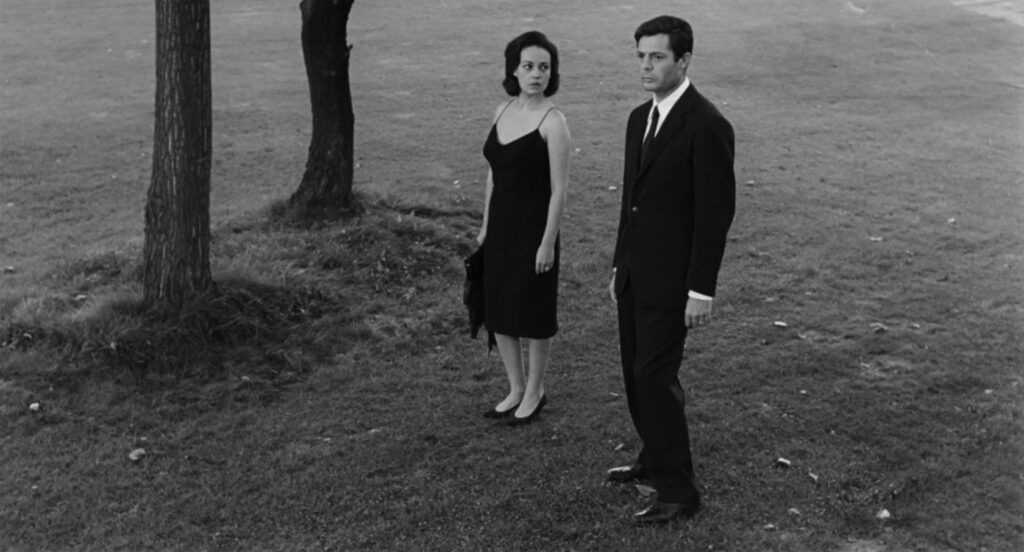
In contrast to Fellini and so many others, Antonioni’s films immerse themselves in life with a seriousness that matches the dancer pouring her whole being into the glass. As a rule he avoids inserting himself into his films. Voice-overs, for example, are anathema to his moviemaking. In La notte however he does insert himself – the Gherardinis’ two servants are named Angelo and Antonio. The director, in other words, is a servant to his material.
The inverted structure of La notte not only opens the ending, it also opens the whole film to numerous understandings. We can view it as a polemic about how movies should be made; we can see it (taking Valentina’s example over Lidia’s) as therapy for the meaninglessness of modern life; or we can find in the dancer with the wine glass a prescription for watching movies, or even for living, with greater intensity. The film is simultaneously small in scale, concentrating on a few characters over a few hours, and large, opening a window into the arc of its characters’ lives and into the nature of time itself. It’s thoroughly ambiguous without calling attention to its ambiguity the way Last Year at Marienbad and Persona do. We can believe that Lidia fell out of love with Giovanni because his love was insincere, or we can believe she rejected him first, and his infidelities are a way of searching for the love he still misses from her. When Giovanni fails to recall writing the love letter, Jeanne Moreau’s acting leaves it open whether she’s shocked or indifferent. All this ambiguity, however, does not blur the film or obscure its purpose. Instead of interfering with our vision, it should – if we’re sufficiently invested – teach us to expand our vision.
CONNECTIONS:
Casablanca – Expression of eternal time lost and recaptured near the end
Early Summer – Reversal of normal placement of the eternal at the end
Ugetsu monogatari – Bracketed by camera motions 90° to each other
The Burmese Harp – Situations resolve less dramatically than expected; letter at end
Hiroshima mon amour – Unheralded daybreak seen through a skylight or window near the end
Night Train – Begins with vertical & ends with horizontal; movement at cross-currents; deprecation of the dramatic; story spans a single night
La dolce vita – Helicopter; nighttime swim; ending at beach/bunker; Mastroianni as a writer; satyr; rainstorm; black horse; nightclub; house party
Knife in the Water – Love triangle where two persons may be viewed as the same person at different ages
Cléo from 5 to 7 – Past, present, and future represented in a walk through city
Band of Outsiders – Broken into two halves by a dance in the middle
Time Walks Through the City – Shots of modern architecture composed like abstract paintings; preoccupation with time
Blow-Up – Moment that models the intensity required to view a film properly
Cries and Whispers – Letter or diary entry at end describing a vision of eternity
The Passenger – Dancer pours herself into a wine glass as Locke pours himself into Robertson